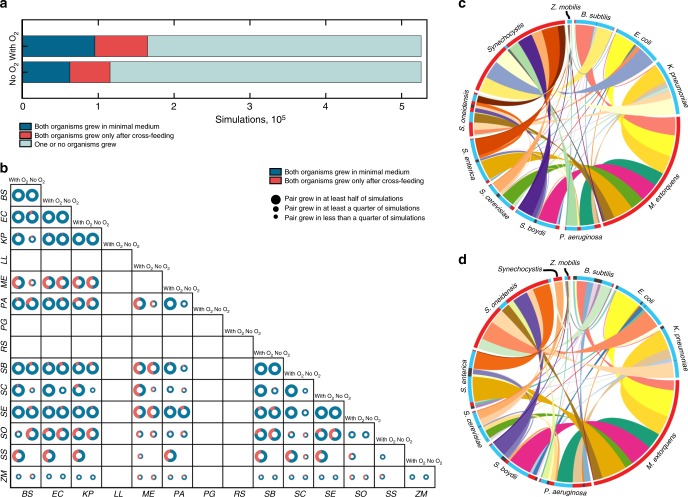Fig. 4.
Growth outcomes of pairwise cross-feeding simulations. a Growth outcomes of all in silico experiments with and without oxygen, grouped by pairwise growth phenotype. b Organism-specific growth outcomes. Size of circles represent the relative number of environments in which an organism was able to grow out of 5774 in silico experiments with each partner. c, d Frequency of obligate pairwise growth by species in single carbon source simulations for oxic (N = 69,420, c) and anoxic (N = 52,897, d) conditions. Each color ribbon is unique to an individual species pair. Width of ribbons is proportional to the number of experiments in which obligate syntrophy was predicted for each species pair. Radial axis colors represent directionality of exchange: blue: organism provided essential metabolites to partner organism in over 75% of simulations; red: organism received essential metabolites in over 75% of simulations; gray: both organisms gave and received essential nutrients in most simulations. Most pairings of organisms were imbalanced, with one organism more frequently providing essential nutrients to another. For example, with oxygen, Synechocystis relied on metabolites from nine different organisms across the vast majority of simulations in which it grew with a partner. As all organisms were grown heterotrophically, carbon dioxide and ammonium were the main byproducts that enabled growth of Synechocystis in these simulations. BS: B. subtilis, EC: E. coli, KP: K. pneumoniae, LL: L. lactis, ME: M. extorquens, PA: P. aeruginosa, PG: P. gingivalis, RS: R. sphaeroides, SB: S. boydii, SC: S. cerevisiae, SE: S. enterica, SO: S. oneidensis, SS: Synechocystis, ZM: Z. mobilis

